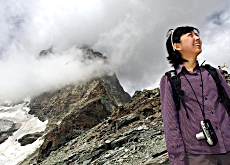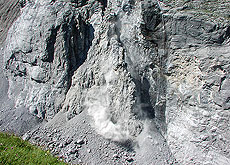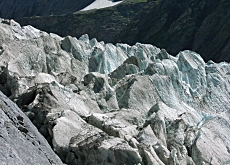Experts warn of more landslides as Alps melt

The risk of rockfalls and landslides in the Alps will continue to grow as the permafrost melts, warn the Swiss authorities.
The Federal Environment Office has now drawn up a list of towns and villages most at threat from Switzerland’s crumbling mountains.
According to officials, all towns and villages situated on the valley floor are in danger of being hit by landslides.
They include the ski resort of Zermatt, which is surrounded on three sides by permafrost-covered peaks, said environment agency spokesman Adrian Aeschlimann. Also on the list are Saas Balen, Kandersteg and St Moritz.
In addition to the risk of landslides, a number of places are threatened by lakes of meltwater. The fear is that natural barriers holding in the water could weaken due to global warming or that rockfalls could send a wall of water flooding over the top of dams.
Wilfried Haeberli, a geology professor at Zurich University, told the SonntagsZeitung that the chances of a major disaster occurring increased as the permafrost melted.
Permafrost, which forms above 2,300 metres, glues rock and soil to the mountain face. But its ability to do so is weakened by rising temperatures.
The issue of disintegrating Swiss mountains was brought home ten days ago by the spectacular mass of rock that broke off the Eiger mountain.
Hundreds of thousands of cubic metres of rock collapsed after large fissures appeared in a giant slab of stone on the Eiger’s eastern flank. Geologists believe the mountainside has been weakened by the retreat of the Lower Grindelwald Glacier over the past few decades.
They say the glacier acted as a supporting wall, and melt water from the remaining ice has been able to seep between the rocks, creating cracks.
Danger list
Haeberli, who helped to compile the environment agency’s danger list, added that it was not simply a question of huge slabs of rock coming down. He warned that these in turn could provoke a chain reaction resulting in damage to residential areas.
He recalled an event in the Caucasus mountains in 2002 when several million cubic metres of rock broke loose, sweeping away a whole glacier. This in turn triggered a massive landslide that completely destroyed a 33km-long valley.
The environment agency’s list will be sent to all the cantons so they can update their charts of natural danger zones. These indicate where there is a risk of rockfalls, landslides, avalanches and flooding.
A study by researchers at Zurich University, published earlier this month, predicted that alpine glaciers would all but disappear by the end of the century if global warming was not halted.
Results of computer modelling experiments show that the Alps will lose 80 per cent of their glacier cover if summer air temperatures rise by three degrees Celsius.
swissinfo with agencies
4-6% of Switzerland is covered by permafrost.
In alpine regions above 2,500 metres, 33% of the area is covered in permanently frozen ground.
Glaciers cover 2-3% of Swiss territory.
Between 1985 and 2000, Swiss glaciers lost 18% of their surface area.
On July 14, 400,000 cubic metres of rock broke off the eastern side of the Eiger.
The previous month a rockfall blocked the main north-south road axis north of the Gotthard tunnel, killing two Germans in their car.
As a result, dangerous overhanging rock had to be removed and the motorway was closed for a month.

In compliance with the JTI standards
More: SWI swissinfo.ch certified by the Journalism Trust Initiative











You can find an overview of ongoing debates with our journalists here . Please join us!
If you want to start a conversation about a topic raised in this article or want to report factual errors, email us at english@swissinfo.ch.